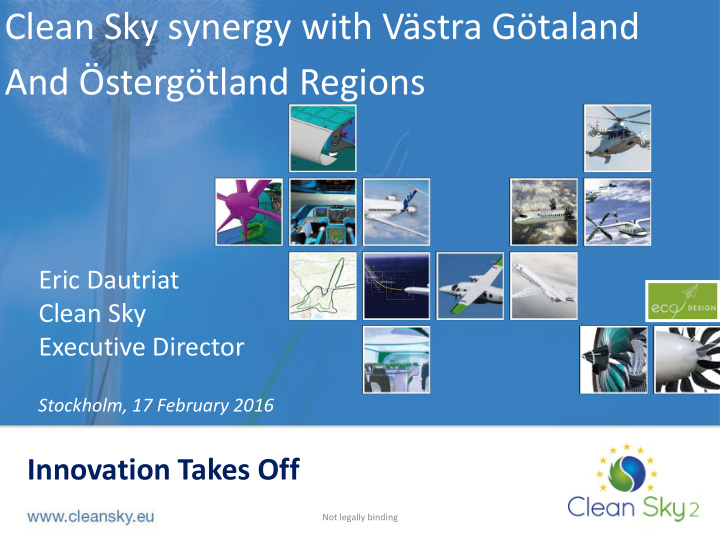



Clean Sky synergy with Västra Götaland And Östergötland Regions Eric Dautriat Clean Sky Executive Director Stockholm, 17 February 2016 Innovation Takes Off Not legally binding
Clean Sky : Innovation takes off Europe’s largest Aeronautics Research Programme(s) ever • A Joint Technology Initiative (“PPP”) with public -private co-funding, 50/50 • Managed by a “Joint Undertaking”, autonomous body • Integrated technologies, industry-led, up to full scale demonstrators • Environment and competitiveness objectives • Clean Sky 2 programme started in 2014, with 4 B € total funding • Most of EU aeronautical R&I funding goes through CS2 now • Organized through technological platforms led by the large industrial integrators
Clean Sky 2 Programme Set-up EU Funding Decision 1.755bn € Regional Fast Large Aircraft Rotorcraft Passenger Vehicle Agusta Aircraft IADPs Alenia Westland Airbus Technology Evaluator (TE) German Aerospace Center (DLR) Aermacchi Eurocopter Fraunhofer Gesellschaft Airframe ITD Eco-Design Dassault – EADS-CASA – Saab Small Air Transport Evektor – Piaggio Large Engines ITD Systems Safran – Rolls-Royce – MTU ITDs Systems ITD Thales – Liebherr About 80% of total EU aeronautical R&I funding Not legally binding Not legally binding
Clean Sky 1, 12/2015: Well into demonstrators New Product emerging from Large technology development: Turbofan ARRANO, selected for new H160 helicopter Diesel cycle E-ecs engine Open Rotor Composite fuselage on ATR72 Laminar wing demo on A340
Clean Sky 2, another set of challenges Increased emphasis on reaching actual TRL6… …but also room for longer -term, lower-TRL projects
Clean Sky 1: an Innovation Chain of 600 entities – a wide ecosystem of SME, RO and Academia with the Industry >550 Partners Selected 65 Associates 12 ITD Leaders Calls for proposals Participants per type of Organization
Why Synergies between Clean Sky and ESIF? Combination of funding under H2020 and ESIF is now allowed and encouraged under H2020 (Article 31 of RfP ) and the “Common Strategic Framework” of ESIF; included in Clean Sky 2 Regulation JTIs can be instrumental for underpinning RIS3 and stimulating credible and coordinated R&I investments Aeronautics is one of the best sectors of excellence in Europe in a globally growing demand (5% per year), i.e. return on public (regional) investment in innovation, geared to the right strategic targets , may be high
Clean Sky action on Synergies with ESIF • A “Clean Sky label” will have an incentive effect and “guarantee of success” for MS/Regions to invest on projects, support actions, infrastructures, facilities in favour of well performed/running actions • a “win - win” strategy for policy makers to direct R&I regional funds toward a credible, global RIS3 strategy: think global, act local • Focus: Regions with aerospace specialisations, or transverse disciplines like materials or embedded systems
Clean Sky JU: a pragmatic approach to synergies with ESIF (1/2) • Being concrete • Answering proposals for co-operation from interested Member States (MS) and Regions with no attempt to a full coverage, with a flexible approach and tailor-made forms of cooperation • Signing MoUs with these MS/Regions in order to set the scene and agree the general framework of a cooperation • Implementing a pilot phase in 2015-2016 with test cases, then assessing the process and improving it for a “cruise phase” starting in 2017
4 scenarios proposed to Managing Authorities • Basic (realistic) principle: CS calls and Regional calls must be kept asynchronous – no try to have any simultaneous / symmetric approach; this drives the mechanisms foreseen • These synergies should be a way to emphasize bottom-up approaches from applicants / beneficiaries • The role of Clean Sky industrial Members is essential for interfacing with the regional capabilities • 5 high-level scenarios identified for driving the appropriate mechanisms for cooperation, to be adapted to the regional funding schemes envisaged under the OPs, rules and processes while keeping the CS Programme/calls in conformity with its own rules
5 scenarios for synergy 1. Upstream support ESIF support for developing capabilities/skills / infrastructures of its local entities in view of planned participation to future CS calls 2. Parallel funding Applicant to CS call ( for Core Partner and CfP) proposing in parallel a separate set of ESIF activities which may be granted ESIF support 3. Sequential funding / downstream support CS partner proposing a continuation / spin-off / amplification of a CS project 4. Thematic approach ESIF support to complement CS Programme through definition, consistently with Regional RIS3 policy of appropriate areas / themes not addressed in CS but contributing to the overall objectives 5. “Seal of Excellence” If appropriate for the programme, the second-ranked proposal in a Clean Sky Call (if highly scored) could be supported by Clean Sky for a separate, parallel funding by the Region (already in place with the SME instrument by EC)
State of play, as of January 2016 • 6 MoU signed in 2015: – Midi-Pyrénées (FR) – Andalusia (ES) – Romania (state level) – Campania (IT) – Catalonia (SP) – Flevoland (NL) • Advanced contacts with ~ 10 other Regions • Call for projects launched by Midi-Pyrénées according to scenario 4 (themes co-defined with Clean Sky JU) • Selection of 2 projects complementary to Clean Sky made by another Region in January, according to scenario 3 Clean Sky 2 nd Call for Proposal opened the door to parallel, • complementary proposals by applicants, according to scenario 2
Västra Götaland - Östergötland Respective focus on manufacturing processes, materials, structures… fits well with Clean Sky 2 objectives Linking with the National Level is a strong asset, not always present in other EU regions E xistence, and growth of a “local” Cluster Let’s select the best scenario(s) now for implementing the MoUs
Recommend
More recommend